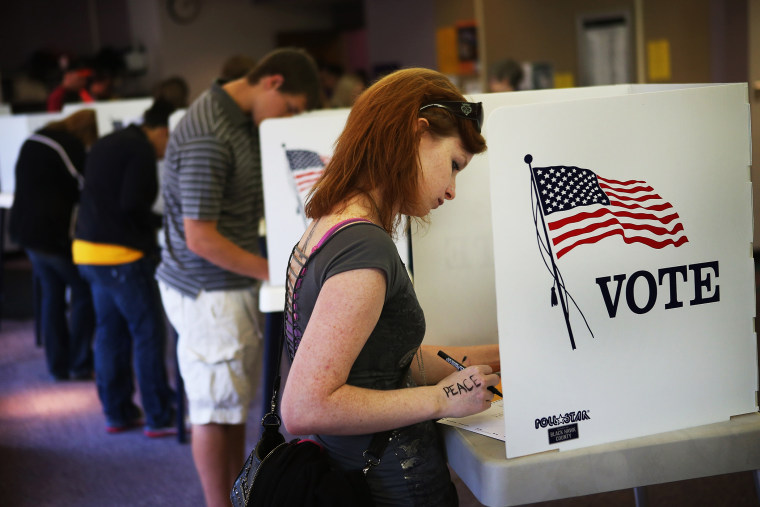Long voting lines were at the top of voters' complaints in 2012 -- and young voters got hit hard by wait times.
A study released Monday from Advancement Project and OurTime.org turned the spotlight on Florida and Virginia, two states that experienced the longest wait times in 2012, and found that young voters turned out “in spite of numerous ballot barriers, not because the system worked efficiently.” How’s that for an apathetic youth?
The study states: “Florida voters experience some of the longest voting lines in the country, with an average wait time of 39 minutes to cast a ballot. That was three times the national average in 2012, of 13.3 minutes.” Matthew Segal, co-founder of OurTime, calls those extra minutes a tax. Not in a monetary sense, but if time is money (as we’ve heard it is) then young voters are feeling the pinch more than others. “The Time Tax doesn’t cost literal dollars and cents, but it’s certainly costing time,” Segal explained to msnbc.com. Those minutes and hours spent on a voting line means less time for jobs, classes, and homework and more hoops to jump through to obtain proper identification and necessary voting qualifications means more people may give up on voting because it’s too time-consuming.
The problem lies in the procedure. Segal explained that while “the partisan intent is very clear on the part of some, we need to fix this from a procedural standpoint and realize it’s part of a larger wave of dismantling the voice of a future generation.”
The study provides seven recommendations for fixing the voting system – including the obvious: make voting more convenient.
OurTime and Advancement Project assert that “convenience impacts turnout” (of course). But most of the recent legislative actions we’ve seen do the exact opposite of that. See: Supreme Court Ruling on Section 5 of the Voting Rights Act, North Carolina Governor Pat McCrory signing legislation severely restricting voting and registration accessibility in the swing state, and Pennsylvania’s attempts to move voting locations further from schools, to name a few.
Looking at North Carolina specifically, that legislation shortened early voting periods, as well as got rid of same-day voter registration. But one of the far-reaching ramifications of this legislation on students is that student ID cards are no longer acceptable as a form of identification at the polls. A disheartening rule-change, the study states, “considering that the state itself found that 612,955 registered voters in North Carolina lack a DMV-issue ID.”
Segal conceded that “some apathy exists” among young voters, but right now “we’re talking about the fact that, procedurally, for voters who want to vote…they have time taxing” as a barrier. And for the 18-29 voting bloc coming of age in a tech-heavy, instant-gratification society, the cumbersome nature of the registration and subsequent voting process, is a turn off. “Procedural barriers can inspire more apathy.”
In the wake of the 2012 election, lawmakers like Sen. Chris Coons, D-Del., introduced legislation that would shorten voting lines and make voting easier for voters. While President Obama has also thrown his support behind election reform, no substantive legislative movements have been made as Congress and the media are sidetracked by the glitchy launch of Healthcare.gov and the pending implementation of Obamacare.
